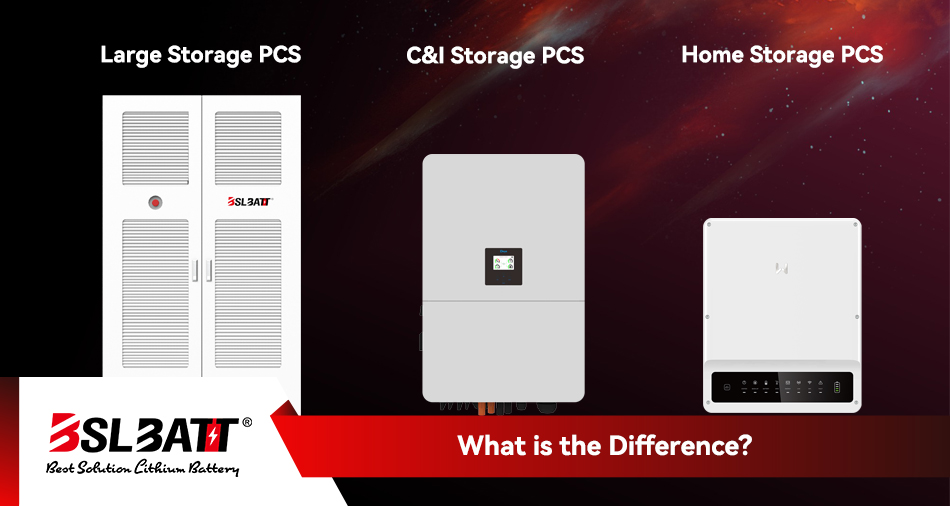Узахоўванне энергііпрамысловасць, PCS, або сістэма пераўтварэння энергіі, пераўтваральнік назапашвання энергіі.
Акумулятарныя назапашвальнікі звычайна падзяляюцца на тры асноўныя сцэнарыі прымянення: вялікія назапашвальнікі, камерцыйныя і прамыслова-сховішчы і хатнія назапашвальнікі, і адпаведныя PCS/інвертары ў розных сцэнарыях таксама вельмі адрозніваюцца. У гэтым артыкуле адрозніваюцца PCS для вялікіх назапашвальнікаў, PCS для прамыслова-сховішчаў і PCS для хатніх назапашвальнікаў па чатырох шырокіх катэгорыях: маштаб магутнасці, сцэнарыі прымянення, тэхнічныя патрабаванні, кошт і цана адпаведна.
I. Шкала магутнасці
Вялікія ПК для захоўвання дадзеных:
Узровень магутнасці высокі, звычайна на ўзроўні МВт (мегават), можа дасягаць 100 МВт і нават вышэй. Буйныя сістэмы захоўвання энергіі могуць захоўваць да некалькіх мегават-гадзін або нават соцень мегават-гадзін энергіі, каб задаволіць патрэбы буйной сеткі ў захоўванні энергіі, рэгуляваць частату сеткі, зрушыць пікі і выконваць іншыя функцыі.
Камерцыйныя і прамысловыя складскія сістэмы (АСС):
Магутнасць звычайна складае ад дзясяткаў кВт (кілават) да некалькіх мегават. Ёмістасць акумулятара, якая прымяняецца прамысловымі і камерцыйнымі карыстальнікамі, вагаецца ад некалькіх сотняў кВтг да некалькіх тысяч кВтг, што выкарыстоўваецца для пакрыцця пікавых тарыфаў і задавальнення патрабаванняў надзейнасці электразабеспячэння.
Хатнія сістэмы захоўвання дадзеных:
Адносна невялікая магутнасць, звычайна ад некалькіх да дзясятка кВт. У асноўным абслугоўвае бытавыя фотаэлектрычныя батарэі, назапашванне энергіі і аварыйнае электразабеспячэнне.сістэма назапашвання энергіі ў хатніх умовахмагутнасць звычайна складае ад некалькіх кВтг да дзясяткаў кВтг.
II. Сцэнарыі прымянення
Вялікія ПК для захоўвання дадзеных:
З боку сеткі: балансаванне попыту і прапановы ў сетцы, згладжванне перарывістай вытворчасці ветравой і фотаэлектрычнай энергіі, а таксама паляпшэнне якасці і стабільнасці электраэнергіі сеткі. Напрыклад, калі буйная фотаэлектрычная электрастанцыя падключана да сеткі, яна можа назапашваць лішнюю энергію на працягу дня і вызваляць яе ўначы або ў пахмурныя дні.
Падтрымка буйных электрастанцый: супрацоўніцтва з буйнымі цеплавымі або гідраэлектрастанцыямі для сумеснага рэгулявання частаты, хуткага рэагавання на попыт на рэгуляванне частаты сеткі і паляпшэння эфектыўнасці рэгулявання частаты энергасістэмы.
Камерцыйныя і прамысловыя складскія сістэмы (АСС):
Зніжэнне пікавых нагрузак і запаўненне спадаў: прамысловыя і камерцыйныя карыстальнікі назапашваюць электраэнергію ў перыяд мінімуму цэн на электраэнергію і аддаюць яе ў перыяд пікавых нагрузак, каб знізіць выдаткі на спажыванне электраэнергіі. Напрыклад, цэнтры апрацоўкі дадзеных зараджаюць акумулятары ўначы і разраджаюць удзень, каб знізіць попыт на пікавую магутнасць з сеткі.
Гарантыя аварыйнага электразабеспячэння: Забяспечваць аварыйнае электразабеспячэнне ключавога абсталявання прадпрыемстваў у выпадку збою электрасеткі, а таксама гарантаваць асноўную працу прадпрыемстваў і нармальную працу важных аб'ектаў.
Хатнія сістэмы захоўвання дадзеных:
Падтрымка вытворчасці электраэнергіі з дапамогай хатніх фотаэлектрычных элементаў: працуе сумесна з хатняй сонечнай фотаэлектрычнай сістэмай для пераўтварэння пастаяннага току ў пераменны для хатняга выкарыстання, прычым лішак энергіі захоўваецца ў акумулятары для павышэння энергетычнай самадастатковасці хатніх гаспадарак.
Рэзервовае электразабеспячэнне: забяспечвае базавую бяспеку электразабеспячэння для хатніх гаспадарак падчас адключэнняў электрасеткі, падтрымліваючы працу важных прыбораў, такіх як асвятленне, халадзільнікі і абсталяванне сувязі.
Ⅲ. Тэхнічныя патрабаванні
Вялікія ПК для захоўвання дадзеных:
Эфектыўнасць пераўтварэння: для зніжэння страт энергіі і павышэння эканамічнасці сістэмы назапашвання энергіі патрабуецца высокая эфектыўнасць пераўтварэння, звычайна вышэй за 95%.
Хуткасць рэагавання: прылада можа хутка рэагаваць на інструкцыі дыспетчарскай службы сеткі, рэгуляваць магутнасць зарадкі і разрадкі за мілісекунды для падтрымання стабільнасці сеткі.
Сумяшчальнасць сістэмы: добрая сумяшчальнасць з буйнымі сістэмамі акумулятараў энергіі і складанымі сеткавымі сістэмамі, адаптацыя да розных характарыстык батарэй і патрабаванняў доступу да сеткі.
Прамысловыя і камерцыйныя складскія сістэмы (АСС):
Надзейнасць: высокая надзейнасць, скарачэнне часу прастою збояў, адпаведнасцьпрамысловыя і камерцыйныяпатрэбы бесперапыннай вытворчасці або эксплуатацыі патрабуюць працяглага сярэдняга часу безадмоўнай працы.
Рэгуляванне каэфіцыента магутнасці: эфектыўна рэгулюе каэфіцыент магутнасці, паляпшае якасць электраэнергіі для прамысловых і камерцыйных карыстальнікаў і зніжае выдаткі карпаратыўнай электраэнергіі за кошт кампенсацыі рэактыўнай магутнасці.
Хатнія сістэмы захоўвання дадзеных:
Бяспека: з бездакорнай сістэмай кіравання батарэямі для прадухілення перазарадкі, пераразрадкі і кароткага замыкання батарэй, каб забяспечыць асабістую бяспеку і бяспеку маёмасці хатніх карыстальнікаў.
Прастата выкарыстання: просты ў эксплуатацыі і абслугоўванні, з простым і зразумелым інтэрфейсам, лёгка ўсталёўваецца і інтэгруецца ў бытавую электрасістэму.
Ⅳ. Выдаткі і цэны
Вялікія ПК для захоўвання дадзеных:
Выдаткі высокія і, верагодна, складаюць тысячы долараў за кілават. Высокая магутнасць, складаныя тэхнічныя патрабаванні і масавая вытворчасць прыводзяць да высокіх выдаткаў на даследаванні і распрацоўкі, сыравіну і вытворчасць, але цэны паступова зніжаюцца з эфектам маштабу і тэхналагічным прагрэсам.
Камерцыйныя і прамысловыя складскія сістэмы (АСС):
Кошт і цана знаходзяцца паміж вялікімі назапашвальнымі сістэмамі акумулявання і бытавымі сістэмамі акумулявання, а цана за кВт можа складаць каля 1000–5000 долараў. На цану ўплываюць магутнасць, функцыянальнасць, брэнд і іншыя фактары, таму прыбытковасць інвестыцый з'яўляецца важным фактарам для прамысловых і камерцыйных карыстальнікаў, якія разглядаюць магчымасць куплі.
Хатнія сістэмы захоўвання дадзеных:
Кошт адносна нізкі, і цана за кВт можа вагацца ад некалькіх сотняў долараў да прыкладна 2000 долараў. Магутнасць невялікая, функцыя адносна простая, і з пашырэннем рынку назапашвальнікаў энергіі ў хатніх умовах чакаецца далейшае зніжэнне цаны, каб палепшыць прыняцце хатнімі карыстальнікамі.
Вялікія сістэмы захоўвання дадзеных PCS для буйных сетак і электрастанцый, высокая магутнасць, строгія тэхнічныя патрабаванні, высокі кошт; прамысловыя і камерцыйныя сістэмы захоўвання дадзеных для прамысловых і камерцыйных камерцыйных сфер зніжкі пікавай нагрузкі і выкарыстання ў надзвычайных сітуацыях, умераная магутнасць, высокая надзейнасць і г.д., сярэдні кошт; хатнія сістэмы захоўвання дадзеных PCS для хатніх фотаэлектрычных сістэм і выкарыстання ў надзвычайных сітуацыях, малая магутнасць, бяспека і прастата выкарыстання, нізкі кошт.
Час публікацыі: 04 студзеня 2025 г.









